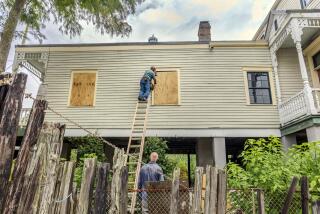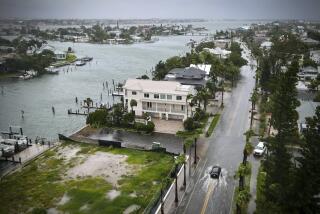Brewing storm casts a cloud on oil spill response
Federal officials Friday scrambled to get ready for the possibility that a tropical storm in the Gulf of Mexico could shut down containment operations at BP’s leaking well and wash large quantities of oil ashore.
A low-pressure area brewing on the northeast coast of Honduras and Grand Cayman has a 70% chance of becoming a tropical storm in the next 48 hours, according to the National Hurricane Center.
Computer models show the storm taking one of two possible routes: moving northwest toward the border of Texas and Louisiana, or northeast across the spill toward the Florida Panhandle.
Coast Guard Adm. Thad Allen, the Obama administration’s point man on the spill, said Friday that federal, state and local governments, working with BP, had a “very robust hurricane contingency plan.”
Five days before gale-force winds, or 40-knot winds, are forecast, Allen said, BP would begin to withdraw the tankers and equipment now capturing oil from the leaking well. It would also shut down the rigs that are drilling relief wells, which are designed to ultimately plug the leak. A tropical storm becomes a hurricane when winds hit 64 knots, or 75 mph.
BP tankers are collecting more than 20,000 barrels of oil a day from a pipe leading down to the wellhead 50 miles off Louisiana. “A storm with gale-force winds could move into a [Category] 2, 3 or 4 hurricane by the time it gets there,” Allen said.
A storm would have “a very negative effect,” Allen said. “At some point we’re going to have to break production and get those production units to a safer locale.... [Our] overall goal in this whole thing is the safety of our personnel. And there are a lot of people on those rigs out there.”
The prospect of withdrawing containment equipment and allowing the blown-out well to spew with uncontrolled force is alarming officials along the gulf. Sen. Bill Nelson (D-Fla.) released a letter Friday calling for Navy vessels to be positioned to help skim oil after any storm passes.
“Figure several days downtime as the storm approaches, a few more days as the storm passes, and a couple more days to get things back into place — and you’re facing up to 10 days or more of the well gushing some 60,000 barrels a day unchecked,” Nelson said.
“That’s 600,000 barrels we’d then have to collect quickly after a storm passed, and before it could hit parts of the Gulf Coast,” Nelson said. “Right now, there just isn’t enough capacity or bigger ships to collect and skim that much oil.”
Allen acknowledged the problem, but told reporters, “I understand the need to skim the oil as soon as we can, but it’s going to be after the storm passes. I don’t think anybody wants a vessel out there trying to skim oil with the weather building beyond gale-force winds.”
He said that Tyndall Air Force Base in Florida would serve as a rescue and coordination center in the event of a hurricane and that “an extensive amount of work is going on between the Coast Guard and “ the Federal Emergency Management Agency to prepare.
The brewing storm system is expected to gather intensity before it reaches the Yucatan Peninsula in Mexico over the weekend.
“We’ll know how strong it will become over the next couple of days, probably by Tuesday,” said Jeff Masters, director of meteorology at Weather Underground, a private forecasting service.
Louisiana’s wildlife-rich coast has a shallow and gently sloping sea bottom, with little ability to stop waves or oil. A tropical storm in the gulf can create waves as high as 12 feet, Masters said.
Even 4-foot storm surges “would certainly put a lot of oil inland, transported by winds,” he said.
At Florida’s tourist-dependent Pensacola Beach on Friday, the mood was one of wishful thinking.
Even as BP cleanup crews patrolled the beach, officials lifted a swimming ban on the county beach after noting that tar balls and swaths of black oil that washed ashore earlier in the week had been removed and had not re-appeared, said Molly Payne-Hardin, a spokeswoman for the Escambia County Health Department.
The University of West Florida and the state Department of Health are testing water samples, she said. But authorities had yet to see the results Thursday. Meanwhile federal officials did not lift an advisory warning against swimming at the adjacent Gulf Island National Seashore.
Meanwhile, a 2009 financial disclosure form was released Friday for New Orleans federal judge Martin L.C. Feldman, who issued an injunction earlier in the week halting the Obama administration’s six-month moratorium on deep-water drilling in the gulf. Feldman owned shares in at least 17 oil and gas companies last year, including an unspecified interest in Transocean Ltd., the owner of the rig that exploded in the April 20 accident. His holdings are not known to include any of the drilling service companies that brought suit against the moratorium.
Times staff writers Julie Cart in Los Angeles, Richard Simon in Washington and Molly Hennessy-Fiske in Pensacola, Fla., contributed to this report.
More to Read
Sign up for Essential California
The most important California stories and recommendations in your inbox every morning.
You may occasionally receive promotional content from the Los Angeles Times.











